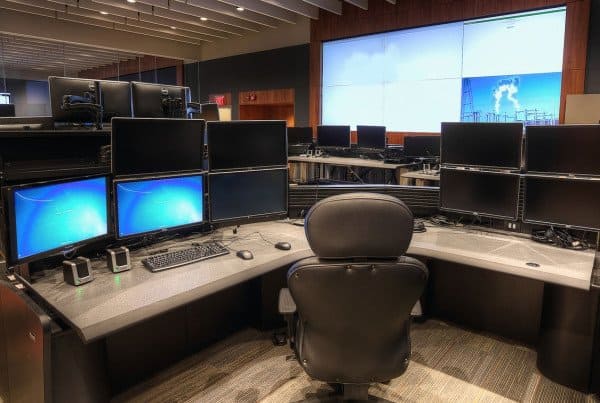Control rooms are some of the most difficult work environments to design — yet also where intelligent design and planning can make a huge difference. In control rooms at power plants, transportation hubs, emergency responder dispatches, police precincts and more, employees are working in a high-stakes environment with little room for error. They must be able to seamlessly interface with technology (often multiple systems), communicate with others and maintain focus at all times — that’s where control room design and ergonomics becomes essential.
When planning a control room, it’s important to consider everything employees will need to work effectively, while remaining comfortable. Working in a control room can be mentally taxing, and without proper ergonomic planning, physically detrimental as well. Anticipate staff needs and use smart design to minimize fatigue and distraction.
Consoles vs Furniture
All office furniture was not created equal. Smart, modular consoles are a must for the modern control room. These specialized pieces were built exactly for your needs, designed to handle high equipment loads and allow for many configuration options. While traditional office furniture makes technology-heavy systems clunky and inefficient, consoles are built with clever design features that make cord management, multiple monitor positioning and ergonomics a breeze. Consoles are built to allow front and rear access to machinery, perfect for frequent repairs, recalibration or IT work.
Perhaps most importantly, consoles are built to last and grow with the company. On average, consoles have a three times longer lifespan than traditional office furniture since it’s crafted to withstand intense wear and tear. Consoles with a modular design can also be taken apart and reconfigured with other pieces to easily expand or redesign the control room layout design. This is crucial for adapting to the changing needs of your organization.
Choosing The Right Space
Furniture alone doesn’t make a control room function. Choosing the right space is also very important. Think realistically about the amount of space needed to fit all consoles and workstations, adding extra room for operators to move around comfortably. A rectangle shape is the ideal use of space, and rooms with columns or large ductwork, slanted walls, or tight corners should be avoided.
A Human-Friendly Environment
In designing a control room, it’s necessary to plan ahead to support employees psychologically as well as meeting their practical needs. In a high-pressure environment, keeping workers feeling comfortable and focused is essential. Windowless rooms with harsh fluorescent light will make staff feel fatigued and wear down morale. North-facing windows are ideal to let in natural light without causing a glare; consider incorporating reflectant paint into your control room lighting design to subtly spread diffuse light if large windows aren’t an option. Sound-absorbing ceiling insulation can help to minimize distraction, and is especially useful in surveillance room design or dispatch call centers. If possible, a separate equipment room should be maintained to hold servers and large CPUs, keeping the heat and sound cut off from the main work area.
The complex environment of the control thrives when people collaborate and seamlessly — both with each other and the technology they depend on. What can easily become a chaotic and inefficient workplace can effectively support busy day to day operations with the help of smart control room design and the right equipment.
